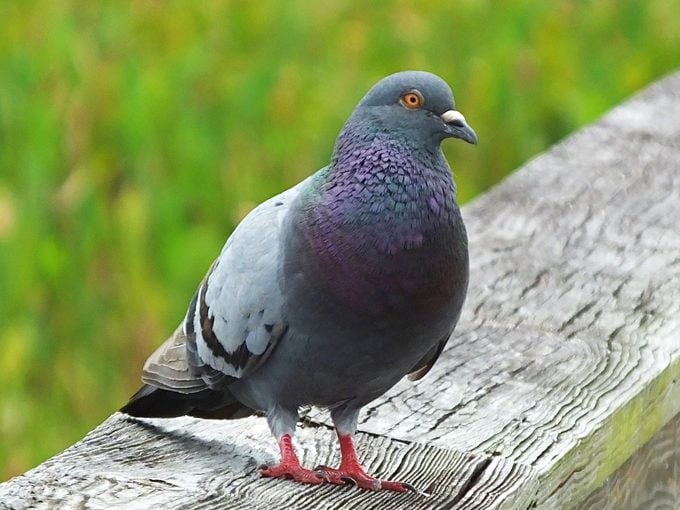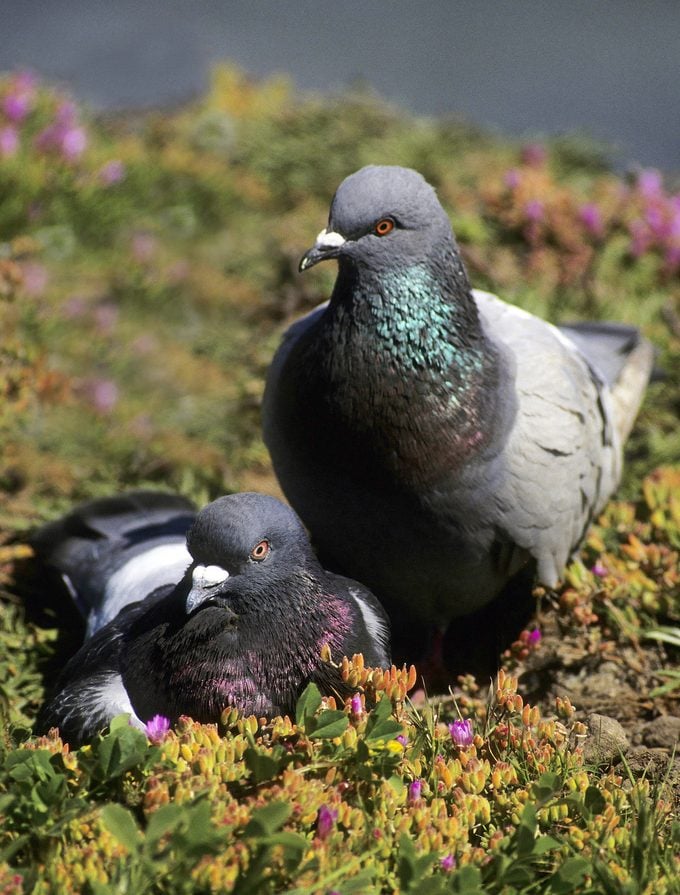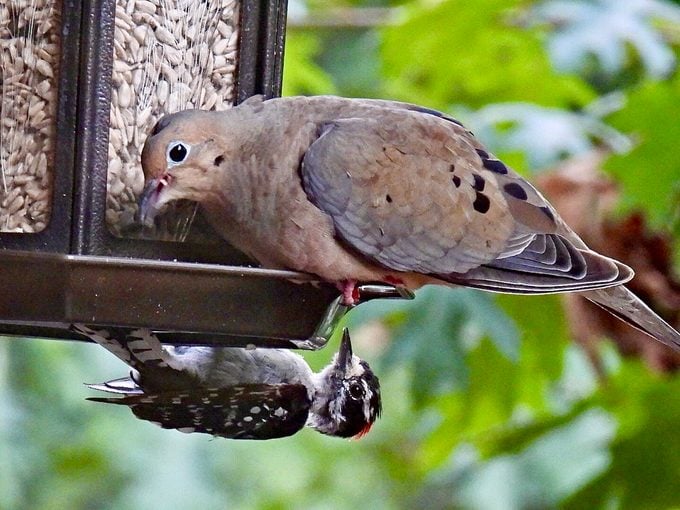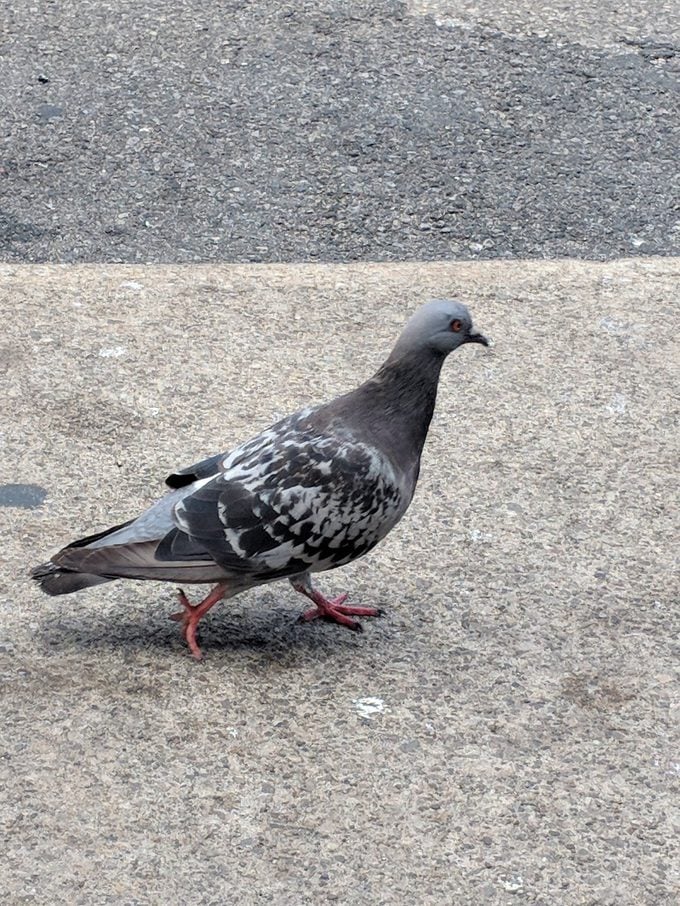How to Get Rid of Pigeons at Bird Feeders
Updated: Dec. 13, 2023
Rock pigeons are nonnative birds that can gobble up lots of birdseed quickly. Learn how to discourage pigeons from visiting your feeders.
On This Page
Ask the Experts: How to Get Rid of Pigeons

“How do I get rid of pigeons at my feeders?” asks Birds & Blooms reader Vivian Tester of Bristol, Tennessee.
Bird experts Kenn and Kimberly Kaufman write, “Pigeons can be a nuisance, especially when they arrive in large flocks, gobbling up loads of seeds. Taking your feeders down for a while is sometimes effective, but there are other options to discourage pigeons, too.
Hanging feeders, especially tube style, are more difficult for pigeons to access. There also are tray-style feeders with cagelike baffles that fit over the top, designed to keep large birds from reaching the seed. Since pigeons prefer to feed on the ground, be sure to keep the area under your feeders clean as well.”
Reconsider giving pigeons a second chance. Here’s why pigeons are the most misunderstood birds.
Attract Songbirds, Not Pigeons
“Pigeons at my feeders are greedy and chase the other birds away. How can I discourage them?” asks Fonda Loring of Cadillac, Michigan.
Kenn and Kimberly say, “Although pigeons are interesting to watch, they may hog a lot of space and push smaller birds away. They cause problems in yards where birdseed is scattered on the ground. To discourage them, try using feeders designed for smaller birds, such as tube feeders with sunflower or Nyjer seed, and prevent seeds from accumulating on the ground underneath.
Suet cake feeders also attract a variety of birds, but not pigeons. If food isn’t readily available on the ground, the pigeons get out of the habit of spending so much time in your yard.”
Did you know that pigeons and mourning doves are related? Here’s how to tell the difference.
What Type of Bird Seed Deters Pigeons?

“What kind of food that pigeons won’t eat can I feed my backyard birds?” asks Niki Reavely of Sun City West, Arizona.
Kenn and Kimberly respond, “Unfortunately, pigeons will eat most kinds of bird food, but you can discourage them with the way you offer it. Pigeons like to feed on the ground or on large open-tray feeders. Nyjer (thistle) seeds in a tube-style feeder attract finches, while sunflower seeds served in a hopper-style feeder with narrow perches attract cardinals and others, but pigeons will find both of these options hard to access.
Suet cakes or peanut pieces offered in wire-mesh feeders may bring in a variety of birds, but usually not pigeons. In addition, you can attach small trays under the feeders to catch any spilled food and sweep up any seeds that accumulate on the ground to prevent additional pigeon visits.”
Psst—here’s why you never see a baby pigeon.
Keep Doves Away From Feeders

“Doves eat at my hopper feeder and keep other birds away. I’ve heard about pigeon guards—would these discourage doves while still allowing cardinals and other birds to use the feeder?” asks reader Pamela Smith.
Kenn and Kimberly say, “It takes some careful work to allow medium-sized songbirds, such as cardinals, to reach the feeder while keeping out doves and other slightly larger birds.
One approach is a pigeon guard or a similar type of wire cage with openings that are just a little too small for the doves to pass through. There are also weight-activated feeders that will close if a heavier bird lands (cardinals weigh a little less than 2 ounces; most doves weigh more than 4 ounces).
It’s worthwhile to visit a local wild bird feeding specialty store to talk to the professionals about the best options for your area.”
What does it mean if you see a mourning dove?
Take a Break From Bird Feeding

When less-desirable birds like pigeons or house sparrows visit your feeders in numbers, sometimes the only options are to take down your feeders until the flocks move on or to embrace the common birds as a fixture of your backyard landscape.
Learn how to get rid of blackbirds and grackles at feeders.
Pigeons Are Nonnative Birds

Rock pigeons, like Eurasian collared-doves and European starlings, are not native to the United States. Introduced from Europe in the 1600s, rock pigeons saved lives carrying messages for the U.S. Army in both world wars. Many are gray with two black wing bars and shiny green or red on the neck.
Pigeons nest in buildings, in barns and under bridges. They feed young with milk developed in their throat pouches.
Next, learn what a white-winged dove looks like.




















